Chapter 43. Virginia Tech: Torgersen Hall
What Is It?
Founded in 1872 as a land-grant institution, Virginia Polytechnic Institute and State University serves the Commonwealth of Virginia as one of its largest research universities. With the main campus located in Blacksburg, Virginia Tech educates more than 27,000 students and operates extension centers, experiment stations, and teaching and research centers across Virginia.
Named after the Virginia Tech president who called for a facility that would advance and demonstrate the university's strategic initiatives in technology, Torgersen Hall is an advanced communication and information technology center. Designed as a student-centered learning environment at the heart of campus, this high-tech center connects to the university's library via a bridge over University Mall, a major entrance to the university. (See Figure 1.) A symbolic bridge between old and new, town and gown, the facility offers opportunities for collaborative learning, research, and service activities that leverage the potential of computing, communications, and information technologies.
Figure 1. Torgersen Hall Bridge Exterior
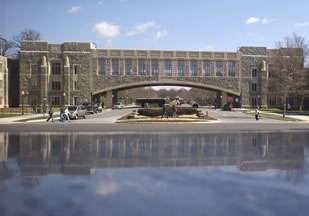
The 150,000-square-foot facility has:
- Wireless connectivity throughout
- Wired classrooms with state-of-the-art audiovisual systems and computer-controlled lighting preset for different teaching scenarios
- Classrooms configured for interactive video distance learning
- High-tech auditoriums
- Observation booths for studying experimental teaching techniques
- A computer-automated virtual environment for 3D virtual reality
- Electronic reading rooms and study courts
- A media center
- Office and laboratory spaces for research activities
- 30 miles of fiber-optic cable and 75 miles of copper cable
Torgersen Hall serves as a physical gateway to digital library assets, research in a myriad of technology arenas, and a complex of activities supported by the university's Learning Technologies division [http://www.it.vt.edu/organization/lt/]. The vaulted bridge connecting to the university library is a heavily trafficked space where students gather to collaborate, access digital content, purchase software, and borrow laptops or Tablet PCs. (See Figure 2.) Ten classrooms function as test beds for determining effective and efficient ways to integrate technology in teaching and learning.
Figure 2. Torgersen Hall Bridge Interior
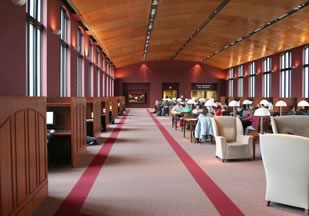
The electronic study court is a focal point for students and faculty engaged in experiments in technology-enriched learning. Adjacent to high-tech classrooms, the study court fosters flexible space use in formal and informal learning activities with support for students collaborating on projects. For example, students and faculty may convene in a classroom to introduce a topic, then adjourn to the study court to work in groups or to the New Media Center on the same floor for assistance with multimedia development. (See Figure 3.)
Figure 3. Torgersen Hall Study Court
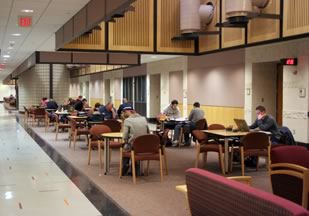
A university resource for all departments and schools, Torgersen Hall also brings together faculty and students engaged in research on the application of technology in areas such as digital library materials, collaborative learning, human-computer interaction, distributed and distance education, scientific visualization, multimedia development, fiber optics, and wireless communication.
What Happens Here?
Ten classrooms serve more than 10,000 students daily. These classrooms support a variety of pedagogical needs including distance-learning classes, computer-integrated classes requiring specialized software, and flexible spaces that encourage experimental approaches to teaching and learning. Three distance-learning classrooms with videoconferencing capabilities allow students and faculty to interact synchronously with students and faculty in Virginia Tech's three distributed graduate centers, other learning sites across Virginia, and beyond. (See Figure 4.)
Figure 4. Torgersen Hall Classroom
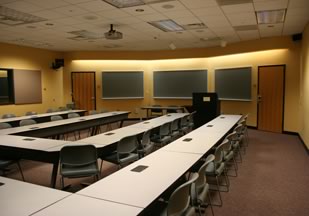
The New Media Center [http://www.nmc.vt.edu/] supports a suite of spaces designed for multimedia production that includes recording studios, video editing equipment, and specialized production software for student projects. (See Figure 5.) To keep the community abreast of the latest multimedia production techniques and to support collaborative projects, this space also contains a training center supported by center staff.
Figure 5. New Media Center
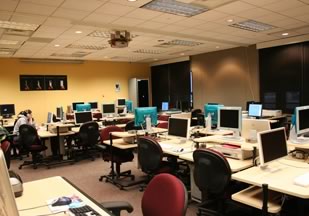
Students use the electronic study court and the bridge to collaborate on team-oriented projects using wired and wireless connectivity that pervades the facility. These informal spaces are in close proximity to experimental classrooms, the New Media Center, software distribution stations, and student support services. The building design promotes informal interactions leading to serendipitous research collaboration. For example, researchers in pervasive computing have joined with applied services staff in nearby assistive technology labs to collaborate on products that will benefit learners with disabilities.
The library partners with the neighboring digital imaging production unit to digitize materials for the university's digital repositories. The physical proximity of these collaborating units is especially important when handling fragile collections.
The 3D computer-automated virtual environment (CAVE) [http://www.cave.vt.edu/] provides a rich learning and research space for exploring concepts across such disciplines as interior design, engineering, chemistry, physics, and entomology.
The award-winning Faculty Development Institute [http://www.fdi.vt.edu/] provides year-round opportunities for faculty to explore the benefits of integrating technology in their teaching and research activities. A three-credit seminar offered through the Graduate Education Development Institute [http://www.gedi.vt.edu/] introduces graduate students to critical pedagogies, e-portfolios, and other resources that might assist them with their professional development. The assistive technologies lab ensures that all students and faculty have access to course content regardless of physical or cognitive disabilities, and the lab hosts a research and development team for advancing the frontiers in learning technologies. The Center for Human Computer Interaction studies people using various technologies to help improve the usability and effectiveness of technology.
How Is Technology Used?
Torgersen Hall incorporates a variety of technologies to support students, faculty, and staff.
Laptop computers: Laptops are available for checkout for ad hoc use by students, and Tablet PCs are available for distribution by faculty to students in class for testing new pedagogical approaches.
Wireless and wired: The entire facility is supported with wireless high-speed Internet access. Optical fiber is routed at a central point through glass brick cylinders that allow for easy adjustment and secure display.
Multimedia classrooms: All classrooms are equipped with a touch-panel interface for using the latest technology. Lighting controls provide several levels of lighting for a variety of learning and discovery activities.
Computer-integrated classrooms: Classes with specialized software requirements meet in these rooms throughout the day and in the evening hours.
Videoconferencing: Heating and cooling systems for these classrooms are designed to register very low noise coefficient ratings so that interactive distance-education activities occur without undue background noise. Also, lighting controls and the acoustical characteristics of materials on the floors, walls, and furniture support distance-education audio and video requirements.
Digital collections: The digital imaging group provides high-quality professional services for creating digital content in collaboration with academic departments. Faculty use these services to digitize instructional content for classes and archives.
What Makes the Space Successful?
Faculty, instructional technologists, and creative architects joined in extensive consultation on innovative and practical considerations for the facility. As ideas turned into drawings, architects continuously gathered feedback from university stakeholders. These conversations resulted in an admired, well-used edifice. University support, through on-site training and technology services as well as competitive grants to faculty for integrating technology in learning activities, encourages experimentation with pedagogy. Students, faculty, and the community at large may receive just-in-time support for instructional and research projects by walking into the New Media Center.
What Principles Were Behind the Design?
The guiding principle in the building design was to create an open learning environment with the flexibility to accommodate the evolving needs of learning in the foreseeable future.
Transparency: Classrooms are located at ground level with large windows to allow the broader community to see inside. These rooms ring a three-story atrium where daylight filters through without heat gain or glare. The balconies ringing this space allow for visual contact vertically and horizontally to promote openness and chance encounters among students, faculty, and staff.
Transitional zones: The electronic study court promotes teaming before and after classes and in round-the-clock general use with comfortable, well-designed, and inviting furniture arrangements. The court also acts as surge space for adjoining classrooms.
Multifunctional: Learning, discovery, and engagement activities range across quiet study spaces, training and multimedia production suites, and experimental classrooms (flexible rooms and large auditoriums). Advanced research suites include digital library research, development, and implementation spaces.
Flexibility: Classrooms have raised access floors twelve inches high to accommodate rewiring efficiently. These rooms also have low-voltage lighting controls to allow for flexible, independent control of lighting setups and to encourage pedagogical innovation. The rooms are bay sized (30 x 40 feet), accommodating a broad range of uses. With no vertical mechanical or electrical elements within the bay walls, spaces as large as 210 x 40 feet could be created. Exposed vertical ducts in the atrium help achieve this flexibility, since they are exterior to the room spaces and also allow other infrastructure that might have run vertically in walls to run horizontally in ceiling plenums.
Groups may comfortably gather in numerous informal nooks. The bridge's more formal study space has help stations and classrooms at either end. Through careful placement of stairs and circulation routes, the bridge may operate on a 24-hour basis without opening adjacent spaces.
What Is Noteworthy?
Outside, a gray-stoned, gothic exterior maintains the integrity of the prevailing campus architecture (see Figure 6), even as a mall-spanning bridge and glass-topped atrium portend a new age. Overstuffed chairs on the bridge offer comfort and support the idea that technology can exist in warm, inviting spaces with views in many directions-to the past, present, and future. Torgersen Hall proves its architect's thesis: if one of information technology's benefits is the freedom to accomplish many things differently, then technology-enabled spaces should express as much in form and function.
Figure 6. Torgersen Hall
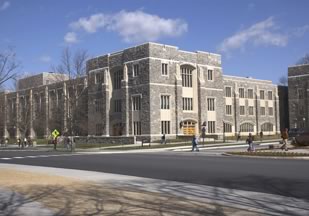
Inside Torgersen Hall, students and faculty creatively blend traditional and new approaches to learning and discovery. Researchers investigating uses of smart materials and sensing devices collaborate with colleagues in assistive technology on applications that help disabled students better navigate the campus. Human-computer interaction researchers scrutinize the usability of these and other innovative applications developed around the building. Faculty and students work easily with resident instructional designers and digital imaging specialists to improve the quality of digital materials they are developing and archiving. Interdisciplinary, technology-enriched teaching and research projects unfold by design as well as from informal encounters in the building. The synergies and emerging communities Torgersen Hall's planners envisioned are being created. (See the e-book resource Web page for short videos of interviews with Virginia Tech professors Carol Burch-Brown and Kerry J. Redican about teaching in Torgersen Hall.)
About the Authors
J. Thomas Head is the director of administration and chief of staff for learning technologies at the Virginia Polytechnic Institute and State University.
Anne H. Moore is the associate vice president for learning technologies and director of information technology initiatives at the Virginia Polytechnic Institute and State University.